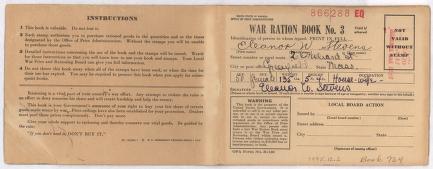




Advanced Search
| Online Collection |
|
|||||||||||||||||||||||||
|
There is currently no available "Beginner" label. The following is the default level label: The United States entered World War II on December 8, 1941. Although the manufacture of all consumer goods was ended in April, 1942, the first home front restriction on food did not come into effect until late November of that year. Coffee, most of which was imported from Latin America, was first to be rationed. Three days later, regional restrictions on the availability of gasoline were extended nationwide. In February, 1943, rationing was extended to shoes: civilians were limited to three pairs of leather shoes annually. In March, a point-rationing system was introduced for processed foods. Each household received coupon books such as this example; the number of coupons was keyed to the number of people in the house. The monthly ration consisted of a series of coupons allowing modest purchases of certain items such as sugar. Consumers could only legally purchase an item if they had the matching coupons. A thriving "black market" in illegal goods sprang up, although it was not extensive enough to undermine the basic intent of the system. In April, 1943, rationing was extended to meats, fats, and cheeses. Special allowances were made for pregnant women and children. Rationing continued to the end of the war, although in April 1944 most meat had been taken off the quotas. Historians have questioned how important rationing was for the war effort, but most agree that it was an important psychological measure to create a sense of sacrifice at home.
|
WWII Ration books and case
|
| |
Home | Online Collection | Things
To Do | Turns
Exhibit | Classroom | Chronologies | My
Collection
About This Site | Site Index | Site Search | Feedback


